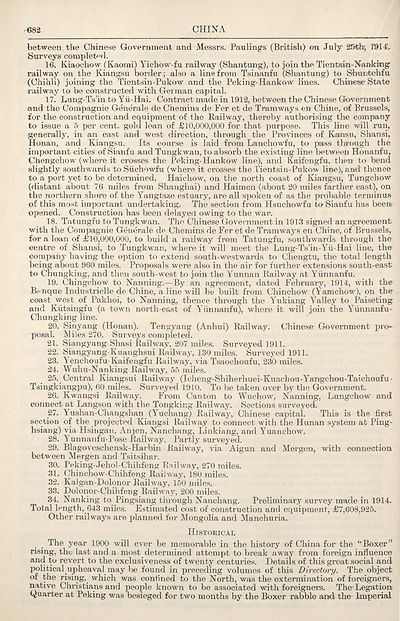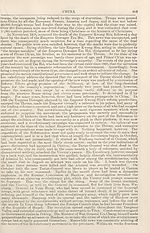1917
(776) Page 682
Download files
Complete book:
Individual page:
Thumbnail gallery: Grid view | List view

CHINA
between the Chinese Government and Messrs. Paulings (British) on July- 25iih!, ]'914V
Surveys completed.
16. Kiaochow (Kaomi) Yichow-fu railway (Shantung), to join the Tientsin-Nanking
railway on the Kiangsu border; also a line from Tsinanfu (Shantung) to Shuntehfu
(Chihli) joining the Tientsin-Pubow and the Peking-Hankow lines. Chinese State
railway to be constructed with German capital.
17. Lung-Ts’in to Yii-Hai. Contract made in 1912, between the Chinese Government
and the Compagnie Generale de Chemins de Per et de Tramways en Chine, of Brussels,
for the construction and equipment of the Railway, thereby authorising the company
to issue a 5 per cent, gold loan of £10,000,000 for that purpose. This line will run,
generally, in an east and west direction, through the Provinces of Kansu, Shansi,
Honan, and Kiangsu. Its course is laid from Lanchowfu, to pass through the
important cities of Sianfu and Tungkwan, to absorb the existing line between Honanfu,
Chengchow (where it crosses the Peking-Hankow line), and Kaifengfu, then to bend
slightly southwards to Siichowfu (where it crosses the 1'ientsin-Pukow line), and thence
to a port yet to be determined. Haichow, on the north coast of Kiangsu, Tungchow
(distant about 76 miles from Shanghai) and Haimen (about 20 miles farther east), on
the northern shore of the Yangtsze estuary, are all spoken of as the probable terminus
of this most important undertaking. The section from Hsuchowfu Sianfu has been
opened. Construction has been delayed owing to the war.
18. Tatungfu to Tungkwan. The Chinese Government in 1913 signed an agreement
with the Compagnie Generale de Chemins de Per et de Tramways en Chine, of Brussels,,
for a loan of £10,000,000, to build a railway from Tatungfu, southwards through the-
centre of Shansi, to Tungkwan, where it will meet the Lung-Ts’in-Yii-Hai line, the
company having the option to extend south-westwards to Chengtu, the total length
being about 960 miles. Proposals were also in the air for further extensions south-east
to Chungking, and then south-west to join the Yunnan Railway at Yunnanfu.
19. Chingchow to Nanning.—By an agreement, dated Pebruary, 1914, with the
Bfnque Industrielle de Chine, a line will be built from Chinchow (Yamchow), on the-
coast west of Pakhoi, to Nanning, thence through the Yukiang Valley to Paiseting:
and Kiitsingfu (a town north-east of Yiinnanfu), where it will join the Yiinnanfu-
Chungking line.
20. Sinyang (Honan). Tengyang (Anhui) Railway. Chinese Government pro¬
posal. Miles 270. Surveys completed.
21. Siangyang-Shasi Railway, 207 miles. Surveyed 1911.
22. Siangyang-Kuanghsui Railway, 130 miles. Surveyed 1911.
23. Yenchoufu-Kaifengfu Railway, via Tsaochoufu, 230 miles.
24. Wuhu-Nanking Railway, 55 miles.
25. Central Kiangsui Railway (Icheng-Shiherhuei-Kuachou-Yangchou-Taichoufu-
Tsingkiangpu), 60 miles. Surveyed 1910. To be taken over by the Government.
26. Kwangsi Railway. From Canton to Wuchow, Nanning, Lungchow and
connect at Langson with the Tongking Railway. Sections surveyed.
27. Yushan-Changshan (Yuchang) Bailway, Chinese capital. This- is the first
section of the projected Kiangsi Railway to connect with the Hunan system' at Ping-
hsiang) via Hsingan, Anjen, Nanchang, Linkiang, and Yuanchow.
28. Yunnanfu-Pose Railway. Partly surveyed.
29. Blagoveschensk-Harbin Railway, via Aigun and Mergen, with connection
between Mergen and Tsitsihar.
30. Peking-Jehol-Chihfeng Railway, 270 miles.
31. Chinchow-Chihfeng Railway, 180 miles.
32. Kalgan-Dolonor Railway, 150 miles.
33. Dolonor-Chihfeng Railway, 200 miles.
34. Nanking to Pingsiang through Nanchang. Preliminary survey made in 1914.
Total length, 643 miles. Estimated cost of construction and equipment, £7,608,925.
Other railways are planned for Mongolia and Manchuria.
Historical
The year 1900 will ever be memorable in the history of China for the ‘“Boxer”
rising, the last and a most determined attempt to break away from foreign influence
and to revert to the exclusiveness of twenty centuries. Details of this great social and
political upheaval may be found in preceding volumes of this Directory. The object
of the rising, which was confined to the North, was the extermination of foreigners,
native Christians and people known to be associated with foreigners. The- Legation
(Quarter at Peking was besieged for two months by the Boxer rabble and' the Imperial
between the Chinese Government and Messrs. Paulings (British) on July- 25iih!, ]'914V
Surveys completed.
16. Kiaochow (Kaomi) Yichow-fu railway (Shantung), to join the Tientsin-Nanking
railway on the Kiangsu border; also a line from Tsinanfu (Shantung) to Shuntehfu
(Chihli) joining the Tientsin-Pubow and the Peking-Hankow lines. Chinese State
railway to be constructed with German capital.
17. Lung-Ts’in to Yii-Hai. Contract made in 1912, between the Chinese Government
and the Compagnie Generale de Chemins de Per et de Tramways en Chine, of Brussels,
for the construction and equipment of the Railway, thereby authorising the company
to issue a 5 per cent, gold loan of £10,000,000 for that purpose. This line will run,
generally, in an east and west direction, through the Provinces of Kansu, Shansi,
Honan, and Kiangsu. Its course is laid from Lanchowfu, to pass through the
important cities of Sianfu and Tungkwan, to absorb the existing line between Honanfu,
Chengchow (where it crosses the Peking-Hankow line), and Kaifengfu, then to bend
slightly southwards to Siichowfu (where it crosses the 1'ientsin-Pukow line), and thence
to a port yet to be determined. Haichow, on the north coast of Kiangsu, Tungchow
(distant about 76 miles from Shanghai) and Haimen (about 20 miles farther east), on
the northern shore of the Yangtsze estuary, are all spoken of as the probable terminus
of this most important undertaking. The section from Hsuchowfu Sianfu has been
opened. Construction has been delayed owing to the war.
18. Tatungfu to Tungkwan. The Chinese Government in 1913 signed an agreement
with the Compagnie Generale de Chemins de Per et de Tramways en Chine, of Brussels,,
for a loan of £10,000,000, to build a railway from Tatungfu, southwards through the-
centre of Shansi, to Tungkwan, where it will meet the Lung-Ts’in-Yii-Hai line, the
company having the option to extend south-westwards to Chengtu, the total length
being about 960 miles. Proposals were also in the air for further extensions south-east
to Chungking, and then south-west to join the Yunnan Railway at Yunnanfu.
19. Chingchow to Nanning.—By an agreement, dated Pebruary, 1914, with the
Bfnque Industrielle de Chine, a line will be built from Chinchow (Yamchow), on the-
coast west of Pakhoi, to Nanning, thence through the Yukiang Valley to Paiseting:
and Kiitsingfu (a town north-east of Yiinnanfu), where it will join the Yiinnanfu-
Chungking line.
20. Sinyang (Honan). Tengyang (Anhui) Railway. Chinese Government pro¬
posal. Miles 270. Surveys completed.
21. Siangyang-Shasi Railway, 207 miles. Surveyed 1911.
22. Siangyang-Kuanghsui Railway, 130 miles. Surveyed 1911.
23. Yenchoufu-Kaifengfu Railway, via Tsaochoufu, 230 miles.
24. Wuhu-Nanking Railway, 55 miles.
25. Central Kiangsui Railway (Icheng-Shiherhuei-Kuachou-Yangchou-Taichoufu-
Tsingkiangpu), 60 miles. Surveyed 1910. To be taken over by the Government.
26. Kwangsi Railway. From Canton to Wuchow, Nanning, Lungchow and
connect at Langson with the Tongking Railway. Sections surveyed.
27. Yushan-Changshan (Yuchang) Bailway, Chinese capital. This- is the first
section of the projected Kiangsi Railway to connect with the Hunan system' at Ping-
hsiang) via Hsingan, Anjen, Nanchang, Linkiang, and Yuanchow.
28. Yunnanfu-Pose Railway. Partly surveyed.
29. Blagoveschensk-Harbin Railway, via Aigun and Mergen, with connection
between Mergen and Tsitsihar.
30. Peking-Jehol-Chihfeng Railway, 270 miles.
31. Chinchow-Chihfeng Railway, 180 miles.
32. Kalgan-Dolonor Railway, 150 miles.
33. Dolonor-Chihfeng Railway, 200 miles.
34. Nanking to Pingsiang through Nanchang. Preliminary survey made in 1914.
Total length, 643 miles. Estimated cost of construction and equipment, £7,608,925.
Other railways are planned for Mongolia and Manchuria.
Historical
The year 1900 will ever be memorable in the history of China for the ‘“Boxer”
rising, the last and a most determined attempt to break away from foreign influence
and to revert to the exclusiveness of twenty centuries. Details of this great social and
political upheaval may be found in preceding volumes of this Directory. The object
of the rising, which was confined to the North, was the extermination of foreigners,
native Christians and people known to be associated with foreigners. The- Legation
(Quarter at Peking was besieged for two months by the Boxer rabble and' the Imperial
Set display mode to:
![]() Universal Viewer |
Universal Viewer | ![]() Mirador |
Large image | Transcription
Mirador |
Large image | Transcription
Images and transcriptions on this page, including medium image downloads, may be used under the Creative Commons Attribution 4.0 International Licence unless otherwise stated. ![]()
| Asian directories and chronicles > 1917 > (776) Page 682 |
|---|
| Permanent URL | https://digital.nls.uk/194542396 |
|---|
| Attribution and copyright: |
|
|---|---|
| Description | Volumes from the Asian 'Directory and Chronicle' series covering 1917-1941, but missing 1919 and 1923. Compiled annually from a multiplicity of local sources and research. They provide listings of each country's active corporations, foreign residents and government agencies of all nationalities for that year, together with their addresses. Content includes: various treaties; coverage of conflicts; currencies and taxes; consular fees; weights and measures; public holidays; festivals and traditions. A source of information for both Western states and communities of foreigners living in Asia. Published by Hongkong Daily Press. |
|---|---|
| Shelfmark | H3.86.1303 |
| Additional NLS resources: |

